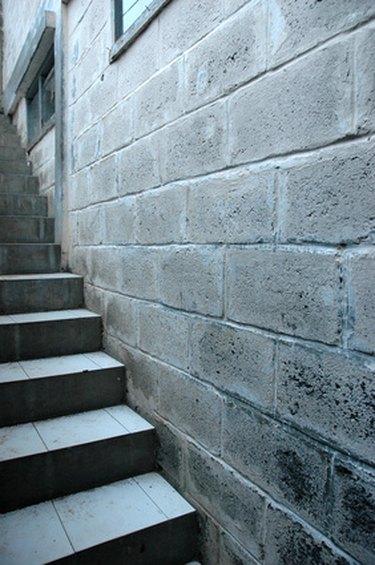Things You'll Need
Bagged type “S” Portland cement mix
2 large plastic tubs (for mixing cement)
Water
Chemical resistant nitrile gloves
Plastic sheeting to protect the floor
Spray bottle
Jointing chisel
Hammer
Wire brush
Jointing tool
Pointing trowel
Compressed air (optional)

Basement wall mortar joints may need to be repointed to increase structural integrity or simply to make the walls look nicer. Fixing cement block mortar joints isn't difficult but does take practice to perform the job neatly. A note of warning: If your basement walls are common cinder or concrete blocks laid in the last 50 years, you're OK to use premixed type "S" Portland cement bags from the home improvement store. If your home is historic or uses brick for basement walls, consult a professional to get recommendations on mortar to use. Mortar that contains too much cement may destroy soft block or brick walls.
Preparing to Repoint Basement Walls
Step 1
Lay down plastic sheeting to protect the floor and make cleanup much easier.
Video of the Day
Step 2
Brush the area that needs repointing with the wire brush to remove loose particles and dirt.
Step 3
Use the chisel and hammer to gently break up and remove the old mortar joints. It is not necessary to remove 100 percent of the old joints; just go in about an inch from the face of the wall and concentrate on the most damaged joints.
Step 4
Use the jointing tool and wire brush to remove excess mortar and other grit until you have clean surfaces. You could use compressed air to blow out the joints if needed.
Mixing Mortar for Repointing Basement Walls
Step 1
Prepare the cement and water mix in one of the tubs. Pour in only as much dry cement as you can use in about 45 minutes. Add a little water at a time until the mortar sticks together in a ball. (It will still be dry and crumbly.) Allow the mix to hydrate for 30 to 45 minutes. Wear your nitrile gloves any time you'll be touching wet cement.
Step 2
Add more water, a little at a time, mixing thoroughly after each addition with your pointing trowel. The consistency you're going for should be like peanut butter -- stiff enough to hold its shape yet plastic enough to work easily. If you happen to add a little too much water, let the mix sit for 10 to 15 minutes to absorb some of the excess water.
Step 3
Stir the mortar just until it's mixed. Overmixing causes the cement to become too wet, which weakens joints and may cause cracked joints as it dries.
Step 4
Hydrate a second batch of mortar while you're using the first, if you'll need more than one batch.
Pointing the Basement Walls
Step 1
Fill the spray bottle with clean water. Dampen the clean joints with a fine spray, making sure to get deep into the joints.
Step 2
Pick up an orange-sized ball of mortar with the trowel. Place the edge of the trowel against the face of the block and use the jointing tool to push mortar into the horizontal ("head") joint, packing firmly. (This is known as "tucking.") Right-handed people find that holding the loaded trowel in the right hand and the jointing tool in the left makes the job easier and faster. Slide the trowel toward yourself as you work. It takes practice!
Step 3
Fill head joints first, then vertical ("bed") joints. Overfill so the mortar is slightly above the face of the block. Work an area no larger than 4 feet by 4 feet.
Step 4
Go back and "strike" the joints with the jointing tool. This simply means drawing the tool steadily and gently across the joint to remove excess mortar, leaving a slight depression. Strike head joints first in a continuous line, then strike each bed joint. If the jointing tool is pulling mortar out, dampen it slightly to make the job go smoothly.
Step 5
Finish by brushing excess mortar off the block faces with the wire brush or your gloved hand.
Tip
If the blocks are severely water damaged, you must fix other problems such as poor drainage or poor waterproofing on the outside basement walls. Repointing the blocks will not prevent future damage.
Video of the Day